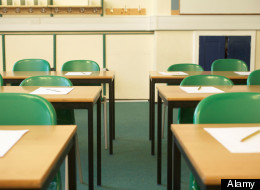No Child Left Behind Law: 8 States Get Waiver From Education-Testing Rules
Posted: 05/29/2012 3:10 pm Updated: 08/29/2012 11:03 am

Less than a week after presumptive Republican presidential nominee Mitt Romney lambasted the Obama administration for not fighting inertia and special interests in America's public schools, the U.S. Education Department announced its latest attempt to free states from federal regulations decried for holding back education.
"Children cannot wait any longer, teachers cannot wait and America cannot wait, so we're moving forward," U.S. Secretary of Education Arne Duncan said on a Tuesday call with reporters.
Duncan said that eight more states could escape some of the strictures of No Child Left Behind, the sweeping 2001 federal education law that required the annual testing of students in English and math and mandated federal sanctions based on those scores. Due to broad dissatisfaction with the law, the Education Department is allowing states that implement pieces of the Obama administration's education platform to work around NCLB's broadest provisions. Specifically, states are granted conditional waivers from NCLB if the Department of Education accepts their proposal to raise standards, tie teacher evaluations to test scores and create new accountability systems that reward or punish schools based on performance.
The administration approved the first group of NCLB-free states in February. The newest states to emerge from under NCLB will be Connecticut, Delaware, Louisiana, Maryland, New York, North Carolina, Ohio and Rhode Island, making for a total of 19 states that are no longer bound by the law. Seventeen other states and Washington, D.C., also applied in the second round, but their plans have not yet been accepted. (Vermont also applied but has since dropped out.)
NCLB expired in 2007, and both Republicans and Democrats agree on the need to revamp the law, due largely to widespread concerns about the effect of standardized testing, which is said to encourage educators to teach to the middle and lower academic standards. Obama gave Congress a fall 2010 deadline to overhaul the law, but the only bipartisan attempt at revision died in committee.
The administration first announced its plans to exchange waivers for reforms this fall, putting the plan under its rhetorical "we can't wait" banner. Duncan said Tuesday he would still prefer a bipartisan bill "that fixes what is wrong with the law while preserving what's right."
The plan is divisive on Capitol Hill. "I have significant concerns about the administration's conditional waivers plan," said Rep. John Kline (R-Minn.), who chairs the House education committee. "It's a temporary band-aid on a problem that must be resolved through legislation."
It has also been criticized for its continued emphasis on standardized testing and for making education plans incoherent across states.
The close timing of the Romney campaign's announcement and the latest news on No Child Left Behind waivers sheds light on the contrasts between the two presidential candidates. When Romney unveiled his education platform in a speech to the Latino Coalition's Annual Economic Summit last week, he pushed back on the "we can't wait" slogan.
"In his speeches, President Obama likes to tell us 'we can't wait,'" Romney said. "If only he would say that and mean it about education reform -- because millions are waiting for change, and so many are missing their chance."
Romney's campaign also released a white paper that called for a rollback of NCLB's federal accountability, replacing sanctions with states' public "report cards" of student performance (the publication of student performance information is already mandated under NCLB.) Romney also advocated open enrollment and the ability for students to use Title I money -- set aside to help schools with large low-income populations -- to help pay for private schools.
"The overall rhetoric is confusing and pretty inconsistent," said Kevin Carey, an analyst at the bipartisan education think tank Education Sector. (Education Sector's interim director John Chubb recently left Romney's education advisory group.) "Most of what the Obama administration has done is to try to give states more flexibility, which sort of cuts against the accusation of a top-down approach."
A Romney representative did not immediately return request for comment.
Romney's plan, Carey says, simultaneously calls for less federal control of education while actually mandating more. "Romney's plan is just as controlling and represents just as robust a potential exercise of federal power," Carey said. "He just wants to exercise it in pursuit of the education policies he likes, which are more focused on school choice."
Civil rights advocates and education experts worry about the lack of federal accountability, because when federal money comes without strings, school systems might spend it on other, less expensive goals. "Romney wants to strip everything bare to just make it test scores that are available to the public," said Jack Jennings, a former longtime Democratic congressional education aide. "I don't see any documentation that there would be any further accountability."
Sandy Kress, a Republican lobbyist who worked on NCLB in the Bush administration, is generally supportive of Romney's plan. "But the weakest part of it is its vagueness on accountability," Kress told The Huffington Post.
"Children cannot wait any longer, teachers cannot wait and America cannot wait, so we're moving forward," U.S. Secretary of Education Arne Duncan said on a Tuesday call with reporters.
Duncan said that eight more states could escape some of the strictures of No Child Left Behind, the sweeping 2001 federal education law that required the annual testing of students in English and math and mandated federal sanctions based on those scores. Due to broad dissatisfaction with the law, the Education Department is allowing states that implement pieces of the Obama administration's education platform to work around NCLB's broadest provisions. Specifically, states are granted conditional waivers from NCLB if the Department of Education accepts their proposal to raise standards, tie teacher evaluations to test scores and create new accountability systems that reward or punish schools based on performance.
The administration approved the first group of NCLB-free states in February. The newest states to emerge from under NCLB will be Connecticut, Delaware, Louisiana, Maryland, New York, North Carolina, Ohio and Rhode Island, making for a total of 19 states that are no longer bound by the law. Seventeen other states and Washington, D.C., also applied in the second round, but their plans have not yet been accepted. (Vermont also applied but has since dropped out.)
NCLB expired in 2007, and both Republicans and Democrats agree on the need to revamp the law, due largely to widespread concerns about the effect of standardized testing, which is said to encourage educators to teach to the middle and lower academic standards. Obama gave Congress a fall 2010 deadline to overhaul the law, but the only bipartisan attempt at revision died in committee.
The administration first announced its plans to exchange waivers for reforms this fall, putting the plan under its rhetorical "we can't wait" banner. Duncan said Tuesday he would still prefer a bipartisan bill "that fixes what is wrong with the law while preserving what's right."
The plan is divisive on Capitol Hill. "I have significant concerns about the administration's conditional waivers plan," said Rep. John Kline (R-Minn.), who chairs the House education committee. "It's a temporary band-aid on a problem that must be resolved through legislation."
It has also been criticized for its continued emphasis on standardized testing and for making education plans incoherent across states.
The close timing of the Romney campaign's announcement and the latest news on No Child Left Behind waivers sheds light on the contrasts between the two presidential candidates. When Romney unveiled his education platform in a speech to the Latino Coalition's Annual Economic Summit last week, he pushed back on the "we can't wait" slogan.
"In his speeches, President Obama likes to tell us 'we can't wait,'" Romney said. "If only he would say that and mean it about education reform -- because millions are waiting for change, and so many are missing their chance."
Romney's campaign also released a white paper that called for a rollback of NCLB's federal accountability, replacing sanctions with states' public "report cards" of student performance (the publication of student performance information is already mandated under NCLB.) Romney also advocated open enrollment and the ability for students to use Title I money -- set aside to help schools with large low-income populations -- to help pay for private schools.
"The overall rhetoric is confusing and pretty inconsistent," said Kevin Carey, an analyst at the bipartisan education think tank Education Sector. (Education Sector's interim director John Chubb recently left Romney's education advisory group.) "Most of what the Obama administration has done is to try to give states more flexibility, which sort of cuts against the accusation of a top-down approach."
A Romney representative did not immediately return request for comment.
Romney's plan, Carey says, simultaneously calls for less federal control of education while actually mandating more. "Romney's plan is just as controlling and represents just as robust a potential exercise of federal power," Carey said. "He just wants to exercise it in pursuit of the education policies he likes, which are more focused on school choice."
Civil rights advocates and education experts worry about the lack of federal accountability, because when federal money comes without strings, school systems might spend it on other, less expensive goals. "Romney wants to strip everything bare to just make it test scores that are available to the public," said Jack Jennings, a former longtime Democratic congressional education aide. "I don't see any documentation that there would be any further accountability."
Sandy Kress, a Republican lobbyist who worked on NCLB in the Bush administration, is generally supportive of Romney's plan. "But the weakest part of it is its vagueness on accountability," Kress told The Huffington Post.

